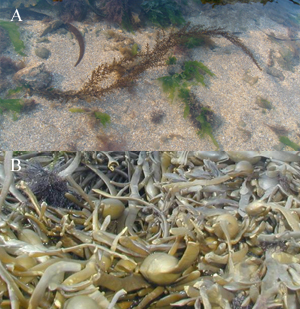The School of Ocean Sciences (SOS), Bangor University has two competitive PhD positions available, applicants must choose from one of several projects with academics in the School. This year, my self and Dr Jan Hiddink have the opportunity to present a project entitled:
Trade-offs in macroalgal chemical defences: Battle of the sexes, invaders and consumers.

Figure 1: A. Sargassum muticum, B. Ascophyllum nodosum
Chemical defences consisting of secondary metabolites are found in some macroalgae with their primary function appearing to be as an anti-grazing deterrent (Ragan & Glombitza 1986). This project will investigate the role that phlorotannins play in the ecology of two canopy forming macroalgae, Ascophyllum nodosum and Sargassum muticum. Ascophyllum is a striking example of an important foundation species commonly found on sheltered shores throughout the North Atlantic. In contrast, Sargassum is a Japanese macroalgae that is a highly successful invader of the UK’s rocky shores, it was first observed in the UK on the Isle of Wight in 1973 and has spread rapidly throughout the coastline, reaching Northern Ireland in 1995, south-west Wales in 1997 and Loch Ryan in Scotland in 2004 (Boaden 1995, Eno et al. 1997, Farnham et al. 1973).
Ascophyllum canopies can have a high biomass and influences biodiversity by providing a stable canopy that facilitates understory algae (Jenkins et al. 1999). This species is relatively long lived, with estimated holdfast ages exceeding 50 years (Åberg 1992) and is considered to be well protected from grazers by the secondary metabolite, phlorotannin with typical concentrations of ca. 5 % of dry weight (Pavia et al. 2003). However, Sargassum has rapid annual growth and comparatively, has lower phlorotannin concentrations of ca. 1-2% (Plouguerné et al. 2006), but has been found to be as high as 8% in certain sites at the height of its reproductive cycle (C. Fendell, MSc).
This proposed project is split into three main themes across several chapters; sexual and reproduction, invasion, and grazers and aims to answer some interesting questions about the ecology of these species.
Chapters 1 and 2, Sexual reproduction and defence: Phlorotannins are energetically costly to produce, so another process must suffer if an individual alga is to develop more in response to an external stressor, but what is sacrificed first, reproduction or growth? To investigate how phlorotannins concentrations are related to sexual reproduction two experimental approaches will be used, firstly, choice/no choice grazing experiments will be used to determine native grazer preference between sexes of Ascophyllum. Secondly, experimental caging in the field will be used to determine if grazer exclusion leads to increased fecundity in Ascophyllum and Sargassum.
Chapter 3, Growth and defence: Previous authors have found higher phlorotannin concentrations in adults of Ascophyllum than in juveniles (Pavia et al. 2003), indicating that juveniles may divert energy to growth as opposed to defence. Sargassum is an exceptionally fast growing alga, it has small perennial section, but the large fronds are annual and appear during spring and summer before breaking up in autumn. Growth will be measured in a range of different sites to determine if patterns similar to those observed in Ascophyllum are present in Sargassum.
Chapters 4, 5 and 6, Grazer palatability and the balance of native/non-native communities: One overlooked area of research for Sargassum is the interaction of this species with native grazer communities on temperate rocky shores. Last year, we found that Sargassum generally has low levels of phlorotannin but under certain circumstances can rapidly produce much greater amounts. If Sargassum is able to produce phlorotannin rapidly, it may be more resistant to grazing pressure than native algae. To determine this, choice/no choice grazing experiments will be conducted with multiple grazers in the laboratory and in the field. Several long-term exclusion and inclusion experiments will be established in the field to determine the temporal interaction of grazers, growth and phlorotannins. Finally, a broad-scale survey throughout the UK coastline will be conducted to determine geographical variability in phlorotannin concentrations for Sargassum and Ascophyllum.
Training: This project will utilise biochemical analyses and experimentation. The student will be taught how to determine phlorotannin concentration, experimental design, field surveys and analysis. Long-term experiments will be established on local shores, and broad-scale survey extending the British coastline will be undertaken to assess the importance of phlorotannins for native and non-native species.
Application procedure
Applications are invited from suitably qualified students for several NERC Quota award PhD studentships in the School of Ocean Sciences. You are eligible to apply if you have or expect to receive a 2.1 degree or higher, you are a UK citizen and you have always lived in the UK. If you have a 2.2 degree, but have also obtained a masters qualification, you are also eligible (see www.nerc.ac.uk/funding/available/postgrad/eligibility.asp).
Interested candidates should send a CV, with the names and addresses of two referees who can comment on their ability and a covering letter, to Andrew Davies (andrew.j.davies @ bangor.ac.uk) by the closing date 31st March 2011. Candidates should ensure they are eligible to apply for NERC studentship by visiting the NERC web pages. One candidate for each PhD will be selected by the supervisor and a further short list of candidates compiled. Candidates will then be invited for interview in late April or early May. Following an offer of a PhD, successful students will be invited to complete a Bangor University PhD application form. Applicants should NOT complete a Bangor University PhD application form until asked.
The PhD description can be downloaded here: [download id=”2″].
